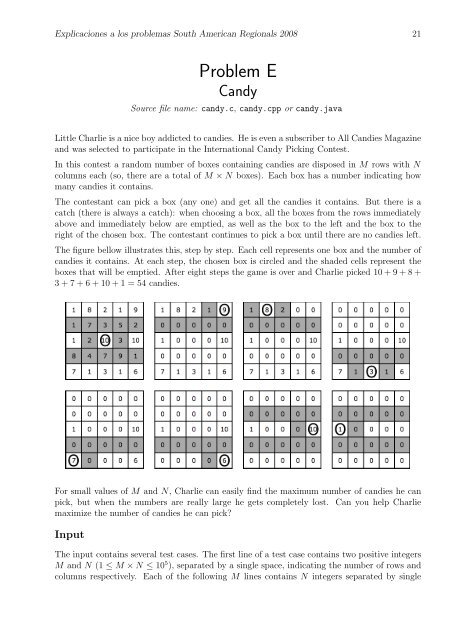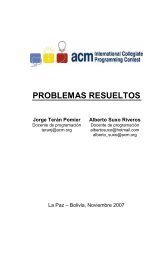Soluciones y Explicación de los problemas ACM ... - ICPC Bolivia
Soluciones y Explicación de los problemas ACM ... - ICPC Bolivia
Soluciones y Explicación de los problemas ACM ... - ICPC Bolivia
You also want an ePaper? Increase the reach of your titles
YUMPU automatically turns print PDFs into web optimized ePapers that Google loves.
Explicaciones a <strong>los</strong> <strong>problemas</strong> South American Regionals 2008 21<br />
Problem E<br />
Candy<br />
Source file name: candy.c, candy.cpp or candy.java<br />
Little Charlie is a nice boy addicted to candies. He is even a subscriber to All Candies Magazine<br />
and was selected to participate in the International Candy Picking Contest.<br />
In this contest a random number of boxes containing candies are disposed in M rows with N<br />
columns each (so, there are a total of M × N boxes). Each box has a number indicating how<br />
many candies it contains.<br />
The contestant can pick a box (any one) and get all the candies it contains. But there is a<br />
catch (there is always a catch): when choosing a box, all the boxes from the rows immediately<br />
above and immediately below are emptied, as well as the box to the left and the box to the<br />
right of the chosen box. The contestant continues to pick a box until there are no candies left.<br />
The figure bellow illustrates this, step by step. Each cell represents one box and the number of<br />
candies it contains. At each step, the chosen box is circled and the sha<strong>de</strong>d cells represent the<br />
boxes that will be emptied. After eight steps the game is over and Charlie picked 10 + 9 + 8 +<br />
3 + 7 + 6 + 10 + 1 = 54 candies.<br />
For small values of M and N, Charlie can easily find the maximum number of candies he can<br />
pick, but when the numbers are really large he gets completely <strong>los</strong>t. Can you help Charlie<br />
maximize the number of candies he can pick?<br />
Input<br />
The input contains several test cases. The first line of a test case contains two positive integers<br />
M and N (1 ≤ M × N ≤ 10 5 ), separated by a single space, indicating the number of rows and<br />
columns respectively. Each of the following M lines contains N integers separated by single



